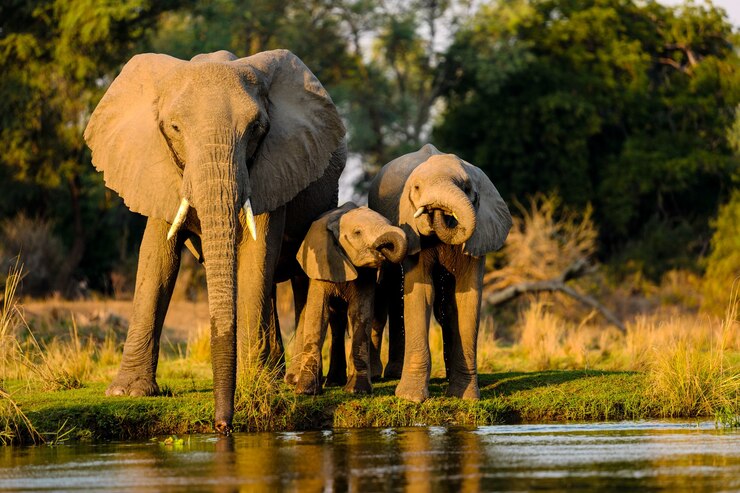Namibia, a vast and arid country located in Southern Africa, is home to some of the most remarkable wildlife and ecosystems in the world. From the Namib Desert to the Etosha National Park, Namibia offers a diverse range of habitats, each hosting unique species that thrive in the country’s harsh but beautiful environments. What truly sets Namibia apart, however, is its pioneering efforts in wildlife conservation. The country has become a global leader in innovative conservation strategies, successfully balancing the need to protect wildlife with the needs of its people.
This article delves into Namibia’s unique wildlife, its conservation success stories, and the strategies that have positioned the country as a model for wildlife preservation in Africa.
Namibia’s Diverse Wildlife
Namibia is home to a variety of species, many of which are endemic to the region or live in rare and delicate ecosystems. The country’s wildlife is adapted to survive in some of the harshest conditions on Earth, from the vast deserts of the Namib to the more temperate savannahs of the central plateau.
Desert Adaptations: The Gemsbok and Desert Elephants
Among Namibia’s most iconic species is the desert-adapted elephant, which has made the harsh Namib Desert its home. These elephants have adapted to the arid environment by developing larger feet to travel across sand dunes and a remarkable ability to survive with limited water sources. The desert elephant population of Namibia is one of the few surviving desert-adapted elephant herds in the world, with about 150 individuals living in the Damaraland region.
Another well-known species, the gemsbok, thrives in Namibia’s desert environment. This antelope is equipped with specialized adaptations, such as a thick coat that helps regulate temperature and long, curved horns for protection. The gemsbok can survive without drinking water for days, relying on moisture found in the plants they consume.
Etosha National Park: A Wildlife Haven
One of Namibia’s crown jewels when it comes to wildlife conservation is Etosha National Park, a vast, salt pan-dominated landscape that hosts an extraordinary variety of animals. Etosha is home to Africa’s “Big Five” – the lion, elephant, leopard, buffalo, and rhinoceros – as well as a wide range of antelope, bird species, and reptiles. The park’s waterholes, which attract wildlife during the dry season, offer visitors an unparalleled opportunity to witness the circle of life in action.
Beyond its popularity as a tourist destination, Etosha has played a critical role in Namibia’s conservation efforts, particularly in the protection of endangered species like the black rhinoceros. The park’s management system, including effective anti-poaching efforts, has contributed to the growth of rhino populations, making it one of the most important sanctuaries for black rhinos in Africa.
The Endangered Cheetah
Namibia is also home to one of the world’s largest populations of cheetahs, particularly in the Namibian farmlands. The country’s cheetah population, estimated at around 3,000 individuals, represents a significant proportion of the world’s remaining cheetah population. Cheetahs in Namibia face challenges from human-wildlife conflict, as farmers often perceive them as threats to livestock. However, through innovative programs like the Cheetah Conservation Fund (CCF), Namibia has made significant strides in mitigating these conflicts. The CCF focuses on research, education, and land-use strategies that allow cheetahs and farmers to coexist peacefully.
Conservation Success Stories in Namibia
Namibia’s commitment to wildlife conservation has produced several remarkable success stories, driven by innovative policies, local involvement, and international collaboration. The country’s conservation model, which blends community involvement with sustainable tourism, has earned it international recognition.
Community-Based Natural Resource Management (CBNRM)
One of Namibia’s most significant contributions to conservation is its Community-Based Natural Resource Management (CBNRM) program, which was first implemented in the early 1990s. Under CBNRM, communities are given the responsibility and the right to manage their local wildlife and natural resources. This approach allows communities to benefit from sustainable tourism, hunting, and land-use agreements while also protecting their local ecosystems.
The Namibian CBNRM program has seen tremendous success in areas like the Kunene Region, where communities actively manage and protect wildlife, including desert-adapted elephants and cheetahs. The success of this program has not only improved wildlife conservation but has also contributed to poverty alleviation, as local communities receive direct financial benefits from eco-tourism and resource management.
The Rhino Conservation Success
Namibia’s efforts to protect its rhino population have been another remarkable success. The country is home to both the black rhino and white rhino, two species that are critically endangered due to poaching and habitat loss. Over the years, Namibia has implemented some of the most stringent anti-poaching measures on the continent. The country’s rhino sanctuary program, which includes both state-managed and privately owned conservancies, has proven highly effective. Namibia’s black rhino population has actually increased in recent years, thanks to a combination of dedicated conservation efforts, effective law enforcement, and community involvement.
In 2020, Namibia was credited with achieving a zero poaching rate for rhinos in certain regions. This achievement is a testament to the country’s effective management of its rhino populations and the dedication of both the government and local communities to conservation.
The Desert Lion Conservation
Another notable conservation success in Namibia is the protection of the desert lion, a unique lion population that resides in the Skeleton Coast of Namibia. The desert lions, known for their ability to survive in extremely arid conditions, have been protected through a combination of research, community outreach, and conservation strategies. In partnership with local communities, wildlife NGOs, and researchers, Namibia has managed to reduce human-lion conflicts and ensure the survival of this unique population.
Through the Desert Lion Conservation Project, Namibia has contributed to global knowledge about lion behavior and desert adaptation. The project also works with local farmers to mitigate conflict and ensure lions are protected rather than persecuted. As a result, the desert lion population has seen a steady increase over the past decade.
Sustainable Tourism and Conservation
Sustainable tourism has become a cornerstone of Namibia’s conservation efforts. The country’s eco-tourism model focuses on offering visitors the opportunity to experience Namibia’s wildlife in an environmentally responsible way. National parks, wildlife reserves, and private conservancies work together to create sustainable tourism experiences that benefit both wildlife and local communities. The income generated through tourism is reinvested into conservation programs, creating a cycle of sustainable growth.
Namibia’s eco-tourism initiatives, such as Wilderness Safaris and Safaris in the Namib Desert, promote responsible travel, ensuring that the country’s unique ecosystems and wildlife are preserved for future generations. Moreover, tourism has raised global awareness about Namibia’s rich biodiversity, attracting international support for conservation efforts.
Challenges to Wildlife Conservation in Namibia
While Namibia’s wildlife conservation efforts have been largely successful, the country still faces several challenges:
- Climate Change: Namibia’s arid landscape is highly vulnerable to climate change. Shifting rainfall patterns, prolonged droughts, and temperature increases pose a threat to wildlife populations and ecosystems. These climate changes affect water availability, plant life, and animal migration patterns, which could disrupt Namibia’s fragile ecosystems.
- Human-Wildlife Conflict: As human populations grow and settlements expand, conflicts between humans and wildlife continue to rise. Farmers often perceive predators, such as lions, cheetahs, and hyenas, as threats to their livestock. Addressing these conflicts remains a key challenge for Namibia’s conservation strategy.
- Poaching and Illegal Wildlife Trade: Despite robust anti-poaching measures, Namibia is still not immune to the broader issue of poaching and illegal wildlife trade, particularly when it comes to species like rhinos and elephants. Cross-border poaching syndicates and global demand for animal products remain significant threats.
The Road Ahead: Namibia’s Vision for the Future
Namibia’s wildlife conservation efforts have already made a substantial impact, but there is still much work to be done. The country’s National Biodiversity Strategy and Action Plan outlines long-term goals for the protection of endangered species, habitat restoration, and climate resilience. As Namibia moves forward, it will continue to innovate, with a focus on sustainable development and community involvement to ensure that wildlife conservation remains a priority.
The combination of government commitment, community-based management, and sustainable tourism makes Namibia a model for wildlife conservation in Africa and around the world. As the world faces mounting environmental pressures, Namibia’s success stories provide a blueprint for balancing biodiversity preservation with socio-economic development.
Namibia’s unique wildlife and conservation success stories highlight the country’s leadership in preserving its natural heritage. Through innovative conservation strategies, community involvement, and sustainable tourism, Namibia has set a standard for wildlife preservation in the 21st century. As challenges persist, Namibia’s commitment to protecting its wildlife will continue to play a crucial role in the fight against global biodiversity loss, ensuring that future generations can experience the country’s extraordinary wildlife and natural beauty.
Join 'Namibia Today' WhatsApp Channel
Get the breaking news in Namibia — direct to your WhatsApp.
CLICK HERE TO JOIN












